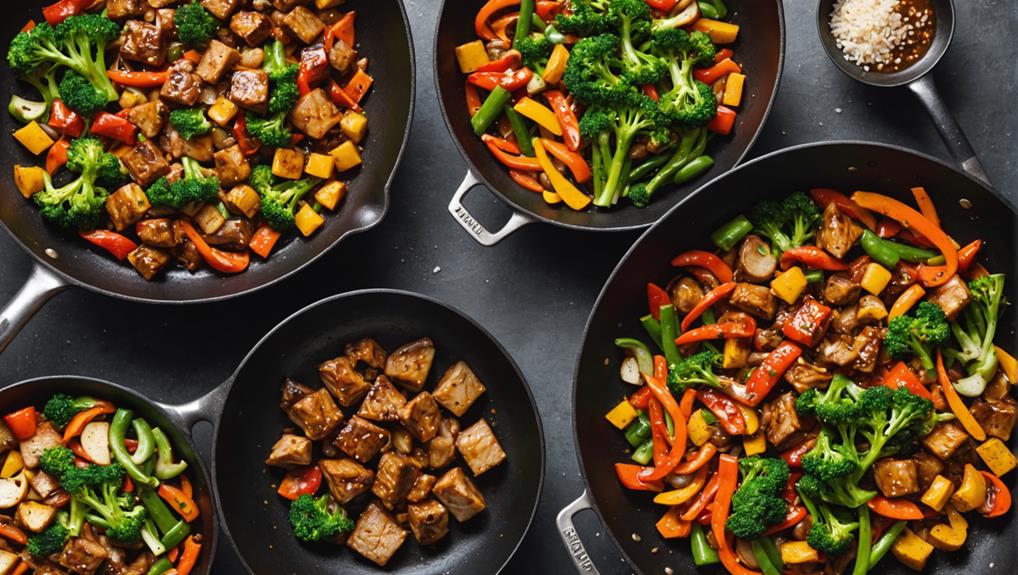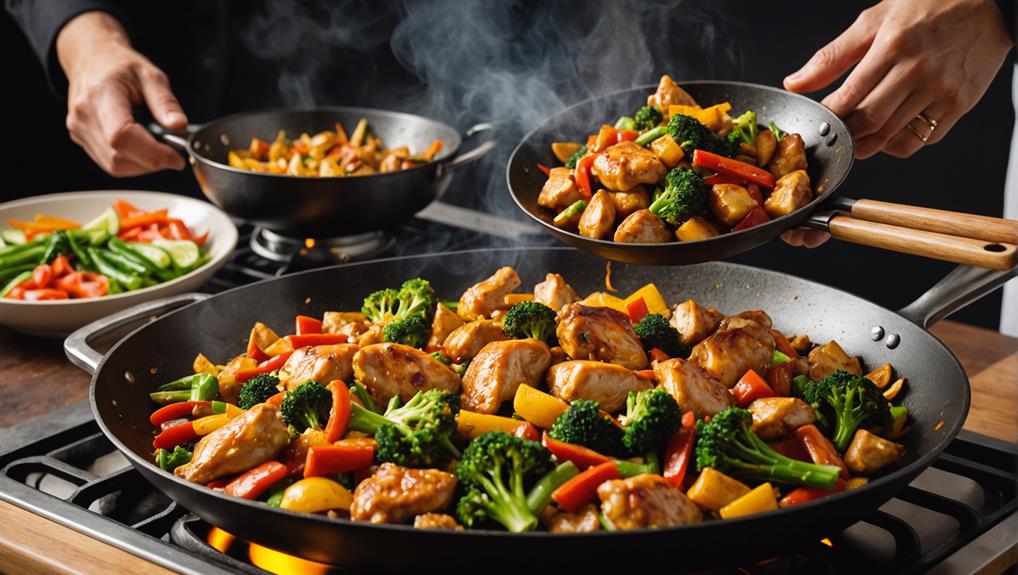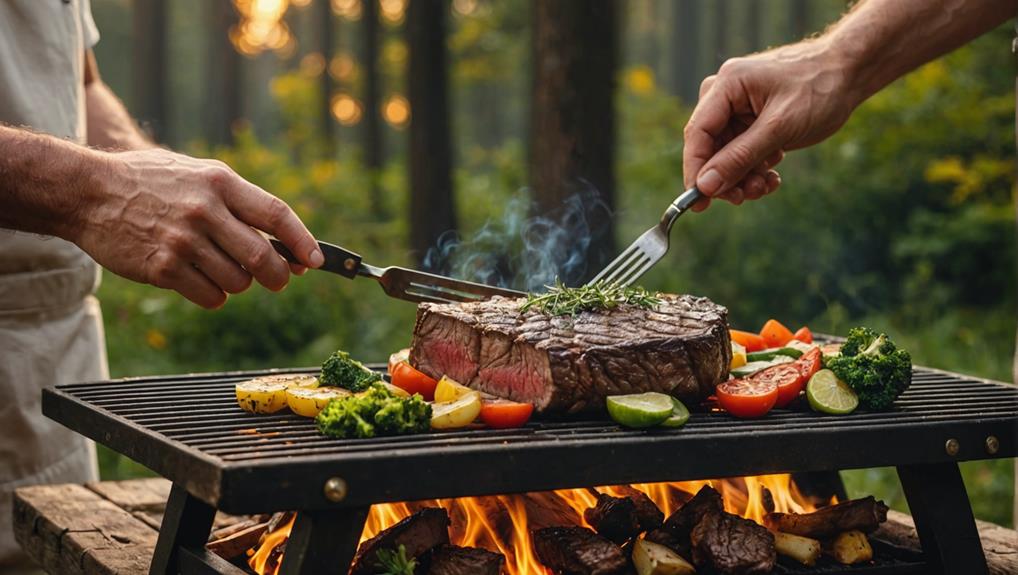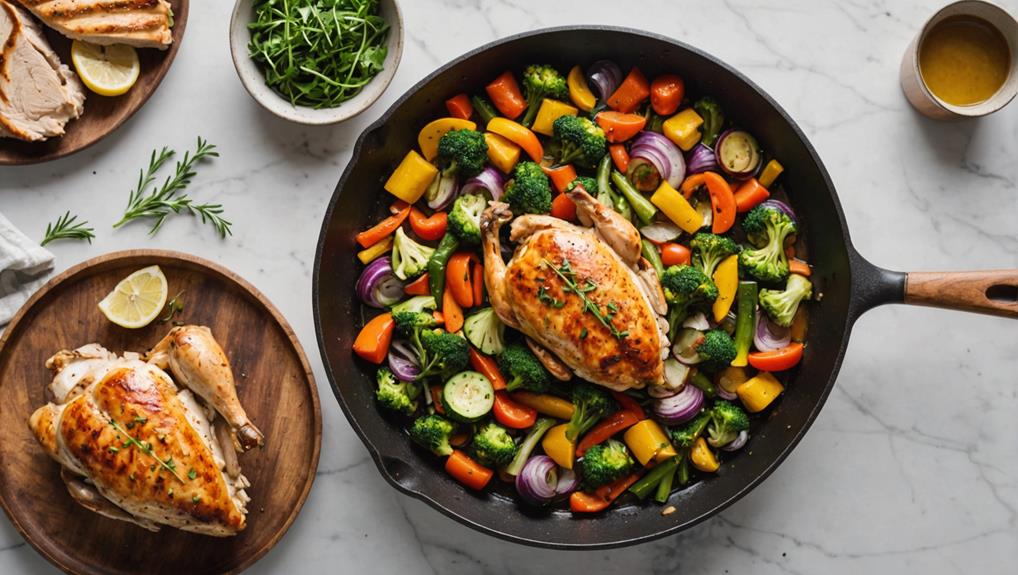Stir-frying and sautéing are distinct cooking techniques that'll elevate your culinary game. Stir-frying, a Chinese method, uses high heat (350-450°F) and constant motion for 2-5 minutes, preserving vibrant colors and crispy textures. Sautéing, a French technique, employs moderate heat (300-400°F) for 4-11 minutes, developing rich flavors through gradual browning. You'll need a wok for stir-frying and a wide, shallow pan for sautéing. Stir-frying requires meticulous preparation and quick movements, while sautéing allows for more control and on-the-fly adjustments. Choose stir-frying for fresh crunch or sautéing for depth and softness in flavors. Mastering both techniques will unlock a world of culinary possibilities.
The Essence of Culinary Techniques
In the culinary world, techniques are the building blocks of great cooking. Two methods that often spark confusion are stir-frying and sautéing. While both involve cooking food quickly in hot oil, they're distinct cooking techniques with unique characteristics.
Stir-frying, a Chinese cooking technique, relies on high heat and constant motion. You'll use a wok to cook ingredients rapidly, preserving their vibrant colors and crispy textures. The key to successful stir-frying lies in thorough preparation. Have all your ingredients ready before you start, as the cooking process happens in minutes.
Sautéeing, derived from the French word for "jump," involves cooking food over medium to high heat in a small amount of oil. You'll use a sauté pan to develop rich flavors and textures, but at a slightly lower temperature than stir-frying. This technique allows for more control over the cooking process.
Understanding these differences will elevate your culinary skills. Whether you're aiming for the intense flavors of a stir-fry or the nuanced taste of a sauté, mastering these techniques will expand your cooking repertoire and impress your dinner guests.
Heat, Oil, and Preparation
Now that we've established the fundamental differences between stir-frying and sautéing, let's focus on the key elements that set these techniques apart: heat, oil, and preparation.
When it comes to heat, stir-frying takes the lead with temperatures soaring between 350°F to 450°F. This intense heat allows you to cook food rapidly, typically in 2 to 5 minutes.
Sautéing, on the other hand, employs moderate heat ranging from 300°F to 400°F, giving you a longer cooking window of 4 to 11 minutes.
Oil plays a crucial role in both methods, but with distinct purposes. For stir-frying, you'll need high smoke-point oils to withstand the extreme heat.
Sautéing offers more flexibility, allowing you to use a variety of oils, including olive oil or butter, to enhance flavor.
Preparation is where these techniques truly diverge. Stir-frying demands meticulous mise en place, with all ingredients prepped in advance due to its lightning-fast cooking process.
Sautéing grants you more leeway, allowing for on-the-fly additions and adjustments. This difference in preparation reflects the innovative nature of each technique, adapting to different cooking styles and preferences.
Choosing the Right Pan

When it comes to choosing the right pan for stir-frying or sautéing, you'll find that the equipment is as crucial as the technique itself. For stir-frying, a 14-inch flat-bottomed carbon steel wok is your best bet. It's designed to conduct heat evenly and can handle the high temperatures required for this cooking technique.
You'll want to use it on a gas burner or outdoor wok stove for optimal performance.
On the other hand, if you're sautéing, reach for a sauté pan. Its wide, shallow design gives ingredients room to sizzle rather than steam, making it perfect for pan frying.
These pans work well on electric or induction stovetops, offering versatility in your kitchen setup.
The choice between a wok and a sauté pan isn't just about preference—it's about maximizing your cooking technique. Woks require constant motion to prevent sticking, while sauté pans allow for brief pauses to develop caramelization.
Ingredient Sequencing and Timing
Mastering ingredient sequencing and timing is crucial for both stir-frying and sautéing. These techniques differ in their approach to cooking time and ingredient order.
In stir-frying, you'll work with high heat and rapid ingredient additions, typically following this sequence:
- Protein first
- Aromatics like garlic next
- Firmer vegetables after
- Quick-cooking items last
- Constant stirring throughout
Stir-frying is a fast-paced culinary dance, usually lasting 2 to 5 minutes. You'll need to move quickly and keep ingredients in motion to prevent burning and maintain crispness.
Sautéing, on the other hand, allows for a more gradual flavor development over 4 to 11 minutes. You'll often start with aromatics to release their flavors before adding other ingredients.
In both methods, it's essential to consider the cooking time differences of your ingredients. Dense vegetables may need to be added earlier than leafy greens, for example.
Developing Distinct Flavor Profiles

Developing distinct flavor profiles is a key differentiator between stir-frying and sautéing. When you're aiming to create innovative dishes, understanding these techniques is crucial.
Stir-frying employs high heat and quick cooking, resulting in vibrant flavors and crisp textures. You'll find that ingredients retain more nutrients, and the addition of flavor enhancers like sherry or lemon juice can elevate your dish's profile with brightness and acidity.
On the other hand, sautéing in a sauté pan over medium heat allows for richer flavor development through browning. This method creates a deeper taste profile, particularly in ingredients like onions and garlic.
As you sauté, you'll notice complex flavors emerging through caramelization and longer cooking times.
To maximize the potential of each technique, consider your desired outcome. If you're looking for fresh, crunchy vegetables with a light flavor, opt for stir-frying. For soft, well-cooked ingredients with pronounced depth of flavor, sautéing is your go-to method.
Frequently Asked Questions
What Is the Difference Between Sautéing and Stir-Frying?
You'll find these techniques differ in heat intensity, cooking times, and motion. Sautéing favors browning in a skillet, while stir-frying keeps veggies crisp in a wok. Choose based on your ingredients and desired outcome for innovative dishes.
What Is the Difference Between Sautéing Stir-Frying and Sweating?
You're on the ball! These key techniques differ in heat, movement, and ingredient selection. Sautéing and stir-frying focus on quick cooking, while sweating emphasizes gentle heat for flavor development. Each method uniquely transforms your culinary creations.
What Is the Difference Between Frying and Sautéing?
When you fry, you'll use more oil and higher heat in a deep pan. Sautéing's your go-to for less oil, medium-high heat, and a shallow skillet. Experiment with different oil types to elevate your culinary game.
What Are the 3 Rules of Stir-Frying?
You'll master stir-frying with these three rules: Embrace high heat techniques for that coveted wok hay. Choose ideal vegetables that cook quickly. Incorporate sauce at the right moment for maximum flavor absorption. It's a culinary dance of innovation!
Final Thoughts
You've now uncovered the subtle dance between stir-frying and sautéing. While both techniques share similarities, their distinct approaches offer unique flavors and textures. Remember, the key lies in mastering heat control, ingredient preparation, and timing. Whether you're tossing vegetables in a wok or gently simmering meat in a sauté pan, you're now equipped to choose the right method for your culinary creations. So, don your apron and let your kitchen become your culinary stage!















